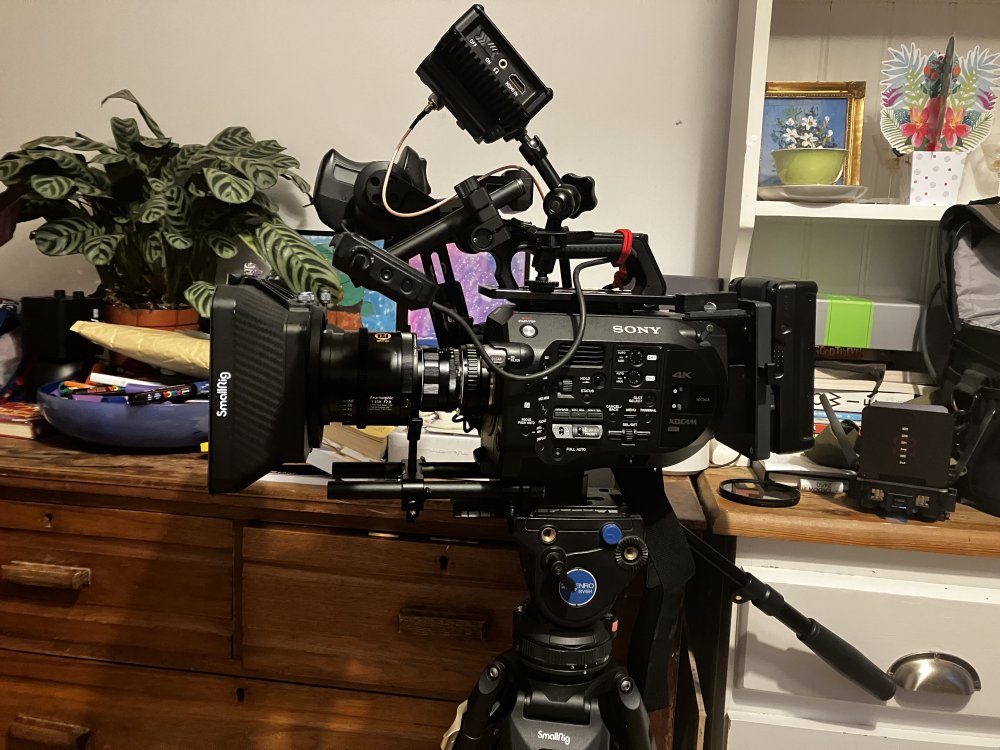Leaderboard
Popular Content
Showing content with the highest reputation on 03/30/2024 in all areas
-

Shooting a short
SRV1981 and 2 others reacted to Tim Sewell for a topic
3 points -
S1/S5/GH5ii?
kye reacted to a_reynolds for a topic
Thanks so much guys! I really dig that image quality isn't really a factor in your answers - can't really go wrong either way so that takes off the pressure. I will ofc compare recording time limits and see what works better for me and have a thought about ergonomics as you pointed out! Definitely! I work in post-production and it's mainly unscripted TV run and gun...natural light all the way expect for interviews. So if I were to talk my way into a shoot MFT would not be the way to go. Can't believe I didn't even think about this! The GH5 was only because I already had the sigma+metabones but when I saw the S line price I was like hold up now might be the time to jump to the S line. Specially because I am only shooting for myself now so I can ease my way into the system without too much pressure 🤑 and for my personal work which is the plan for the next couple of months, I like to use the Super Takumars, Helios and I just got a Canon FD so there's really nothing stopping me from making the change. Thanks a lot guys!!1 point -

S1/S5/GH5ii?
a_reynolds reacted to kye for a topic
It's hard to recommend the GH5 at this point, despite the fact that I'm a passionate MFT user, when the specs of the S5 and S1 are so much better. You can make great content on anything of course, but better specs gives you more options on set, or means you don't have to be as picky about lighting etc, and when you're on set, time is money. I'll paraphrase the recommendation from @KnightsFan and suggest you start with your end goal and work backwards. Your end goal is to create a certain type of content with a certain type of look. This will best be achieved using a certain type of shooting and a certain type of equipment that makes this easier and faster. Then look at options for lenses across the crop-factors, then choose your format/sensor-size, then the camera body. Going the other way results in nonsensical decisions!1 point -

World's smallest DSLM that shoots 4k?
kye reacted to John Matthews for a topic
The 14-140 is definitely on my short list. I think I might go with the 17mm f/1.8 for indoor stuff/low-light.1 point -

S1/S5/GH5ii?
a_reynolds reacted to MrSMW for a topic
If you wanted the lightest and most compact FF unit, then the S5, obviously. If you are going to rig it, probably also the S5. But if it’s bare bones body, lens and maybe a shotgun mic, the S1 is the better platform. Weight, ergos etc… Former S1R and S5 owner plus current S1H and S5ii user. I have my S5ii semi-rigged with cage, side handle, shotgun and my S1H is totally bare bones except Rode Wireless Go.1 point -
S1/S5/GH5ii?
a_reynolds reacted to KnightsFan for a topic
My opinion is to go for an S5. I got one a few months ago for about $800. That opinion is partially based on having owned and primarily shot on a MFT Z Cam for the past 3(?) years and using APS-C NX1/XT3 for the 5-6 years before that. I primarily shoot scripted narrative projects, and nature photography. The increased dynamic range and noise performance of the S5 over the GH5 is definitely a factor for me. Actually, for $800, I can't recommend the S5 enough, if you don't need AF. Absolutely wonderful camera for me. However, my choice of camera is primarily lenses, while you specifically said lenses are not a factor. I have many beautiful vintage photo lenses, and in general I've had an easier time finding modern, high quality FF lenses than APS-C or MFT lenses. It's hard to find a small sensor combo that matches the price/performance of (used) Sigma Art, Canon L, or Zeiss Milvus--keeping in mind that, for my use, autofocus is never in play. (The 18-35 is a standout lens, a notable exception to the generalization I just made) If you are set on real cinema lenses, a smaller sensor might be better. There are plenty of Super 35 options to choose from, and honestly the budget FF lenses (Meike, DZOFilm, etc) are optically rather lackluster in my opinion. If my plans this year go through and I shoot a lot more narrative content, I might look for a Super 35 cinema camera, because at that point we would rent high quality cinema lenses, and there are a lot of those available for Super 35. I don't know much about the S1, but the reason I got an S5 is that it weighs a lot less than the S1. It would be less fun to take an S1 on a backpacking trip.1 point -
Shooting a short
Tim Sewell reacted to KnightsFan for a topic
Awesome! Have fun and good luck! I am also making a short film tomorrow. Definitely looking forward to hearing about how well your shoot went!1 point -
Thanks! I actually did try to crush the blacks, mainly to keep noise down but also because like you I see no reason to reveal detail in shadows that isn't helpful to the image or wasn't visible at the venue (and believe me, not much was visible..this place is really, really dark!). And I do have my eye on the new Micro studio G2; I want to see if anything else is announced at NAB (unlikely but possible) before I pull the trigger, but it would be a nice addition. I'll try playing with boosting the saturation and contrast even more than I already did (I boosted saturation to 60 percent already; I'll try 70 or 75). Exposed at 1600 this was already quite underexposed and I had to boost exposure by at least 2-3 stops just to be able to see much in the footage.1 point
-
World's smallest DSLM that shoots 4k?
John Matthews reacted to ac6000cw for a topic
My combo is usually the 14-140mm plus 25mm F1.8. On my last 'serious' trip (almost two weeks of railway video/stills photography in Southern California), I took a G9 + 14-140mm + 25mm F1.8 (for low light), used hand-held, with G80 + 12-32mm used as an occasional tripod-mounted 'B' cam. I took the G80 instead of the (smaller) GX80 because it has a mic jack. If I were doing a similar trip now I think it would be OM-1 (main) and ZV-1 (B-cam), but lens choice for the OM-1 would be harder as I recently bought a used Oly 12-100mm F4 IS Pro. It's much larger and heavier than the 14-140mm Pana, but it supports Sync-IS on Oly/OMDS bodies and the overall stabilisation performance is fantastic. If you buy a used Pana 14-140mm F3.5-F5.6, be careful about which version you are getting. Panasonic sold the Mk 1 version (H-FS14140) in two different markings - white, gold and red 'HD' lettering (earlier lenses) or all white lettering (later lenses). Then they updated it to the Mk 2 (H-FSA14140) with weather sealing and all white lettering. AFAIK all are optically the same, and support Dual-IS and Dual-IS2. I've come across dealers who've mixed up the white-lettered later Mk 1 and the Mk 2 versions in their used listings...1 point -
Another thought and that is have you considered a full frame lens? I wasn’t going to, but testing the photo side of my kit on 2x portrait shoots, I decided I did have a hole in my lineup...so bought another Tamron E Mount lens, the current version of the 28-75mm f2.8 Now I suspect in FF flavour you are going to call that too short, but on your APSC camera, it’s going to be a 42-112/3 equivalent. Still too short, IDK, only you can answer that, but it weighs basically the same as the APSC 17-70, so thought it was worth mentioning?1 point
-
8 bit 420 can be just fine as long as you don’t want to do anything to it later grade wise. As long as you’re happy with what comes out of the camera then you won’t SEE much of a difference. you will definitely SEE the difference between 8bit and 10bit if you try to match two cameras that look different of if the WB is off or has some lighting hue you don’t like. Basically anytime you want to grade or manipulate the image it is very brittle and won’t handle much correction. 10 bit will.1 point
-
10-bit is always better than 8-bit, and 4:2:2 is always better than 4:2:0, but the question is if that difference is actually visible / meaningful. If you're doing very little grading in post then 8-bit vs 10-bit and 4:2:0 vs 4:2:2 probably doesn't have any visible or meaningful difference. But I suggest doing a test. Just find a bunch of scenes around the house (or not out of the way) and shoot the same composition in each mode and then just load them up side-by-side and look at them. If the 8-bit 4:2:0 shot doesn't make your stomach turn then just go with it. In the end, if you can lessen the impact or eliminate overheating, that you can lessen or eliminate the impact of running out of SD card space, then that means you can relax more while recording, you could shoot more, you can have extra time and energy and headspace that was previously devoted to worrying about or managing these things. If you can have more headspace and be more relaxed while shooting then the way you use the camera, and the way that you behave while recording will be better. If you behave better then what is in front of the camera might also be better. So, realistically, the option is potentially of having a very slightly worse recording of potentially much better material.1 point
-
As I'm sure you know and you just misspoke, you need an external drive for 12bit 4K, not an external recorder. You can shoot internal 12bit 1080p, but ML Raw has an undeniably better IQ, in all respects, than the FP's FHD. I agree about the IBIS, but I don't really see a point for ML Raw with the R5? You can already shoot internal raw. But all of the Canon IBIS cameras are Digic X, so it will be a long time before they break that code. It will be interesting to see what they can do with the EOS-R and hopefully the M50. I'd actually be really happy if they were able to enable continuous MLV raw on the 5D4. But I'm still really impressed with what the 5D3 with ML Raw and a Canon IS lens is capable of handheld. So maybe I'm just easily impressed.1 point

